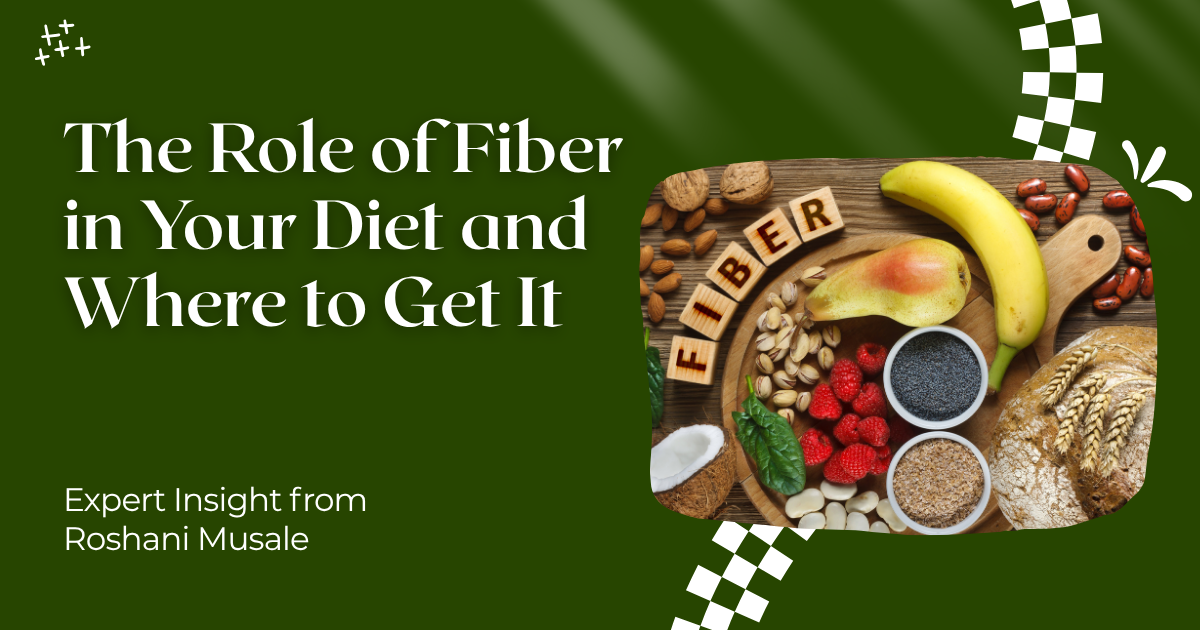Introduction
When we talk about balanced nutrition, protein and vitamins often take the spotlight. But there’s a quiet hero that’s just as essential for your well-being — fiber. In this comprehensive guide, Dietitian Roshani Musale from Reform Wellness explains the role of fiber in your diet, its powerful health benefits, and how to include it effortlessly in your daily meals.
What Is Fiber, Really?
Fiber is a type of carbohydrate that the body can’t digest. Instead of being broken down and absorbed, it passes through your digestive system, keeping it clean and functional.
There are two main types:
- Soluble fiber: dissolves in water to form a gel-like substance (oats, apples, beans)
- Insoluble fiber: adds bulk and helps food pass quickly through the stomach and intestines (whole wheat, vegetables)
Health Benefits: Why Fiber Matters
Fiber plays a crucial role in various body functions:
- Promotes regular bowel movements
- Lowers cholesterol levels
- Controls blood sugar spikes
- Helps in weight management
- Supports gut microbiota (good gut bacteria)
Quote from Roshani:
“A fiber-rich diet doesn’t just prevent constipation — it supports heart health, blood sugar balance, and sustained energy.”
Fiber and Weight Loss
Fiber helps you stay fuller for longer, naturally reducing calorie intake without the need for strict diets.
Real-Life Example: Neha, a 28-year-old client, added fiber to her meals through chia seeds, oats, and raw veggies. In 3 months, she lost 5kg without cutting any food groups.
How Much Fiber Do You Need?
According to ICMR and WHO:
- Women: 25g per day
- Men: 30–38g per day
Most people get less than half of the required fiber. It’s time to change that!
Top 15 High-Fiber Foods to Include in Your Diet
| Food | Fiber (per 100g) |
|---|---|
| Oats | 10g |
| Lentils | 7.3g |
| Chia seeds | 34g |
| Raspberries | 6.5g |
| Apples (with skin) | 2.4g |
| Whole wheat flour | 12.2g |
| Carrots | 2.8g |
| Broccoli | 2.6g |
| Flax seeds | 27g |
| Guava | 5.4g |
| Beans (Rajma, chole) | 6–9g |
| Sweet corn | 2.7g |
| Almonds | 12.5g |
| Spinach | 2.2g |
| Barley | 17.3g |
Fiber and Gut Health
Fiber acts as a prebiotic — it feeds the beneficial bacteria in your gut, which in turn:
- Improves digestion
- Enhances immunity
- Reduces inflammation
Case Study: Anirudh, age 40, had persistent bloating and acidity. By simply increasing fiber intake with leafy greens and millets, symptoms reduced within weeks.
Easy Ways to Add Fiber to Every Meal
Breakfast
- Add chia or flax seeds to smoothies or oats
- Choose multigrain bread or poha with veggies
Lunch
- Add 1 bowl of salad with legumes (e.g., sprouts, chickpeas)
- Swap white rice with brown rice or millet
Dinner
- Mix dal with vegetables like spinach, bottle gourd
- Add psyllium husk (isabgol) if constipated
Snacks
- Makhana (fox nuts), roasted chana, fruits with skin
Fiber Supplements – Yay or Nay?
Whole foods are always better, but if you’re consistently low on fiber, Roshani recommends:
- Isabgol (natural psyllium husk)
- Inulin powder (plant fiber prebiotic)
- Fiber-rich protein bars (low sugar)
Always consult a dietitian before using fiber supplements regularly.
Common Myths About Fiber
- Only old people need fiber – Everyone needs it for gut health.
- Fiber causes gas and bloating – If added too quickly, yes. Gradual increase solves this.
- Fruits and juices are the same – Juice removes fiber. Eat whole fruits!
Client Feedback: Ritu, 52 – Solving Constipation Naturally
Ritu relied on laxatives for years. After a consultation with Roshani, she increased her daily fiber intake with flax seeds, oats, and legumes. Within a month, her bowel movements normalized without medication.
Frequently Asked Questions
Q1: Can kids have a high-fiber diet?
Yes, but it should be age-appropriate and fiber sources should be varied.
Q2: Does cooking reduce fiber content?
Yes, slightly. Steaming is better than boiling to preserve fiber.
Q3: Can fiber help PCOS or diabetes?
Absolutely. It stabilizes insulin levels and aids weight management.

